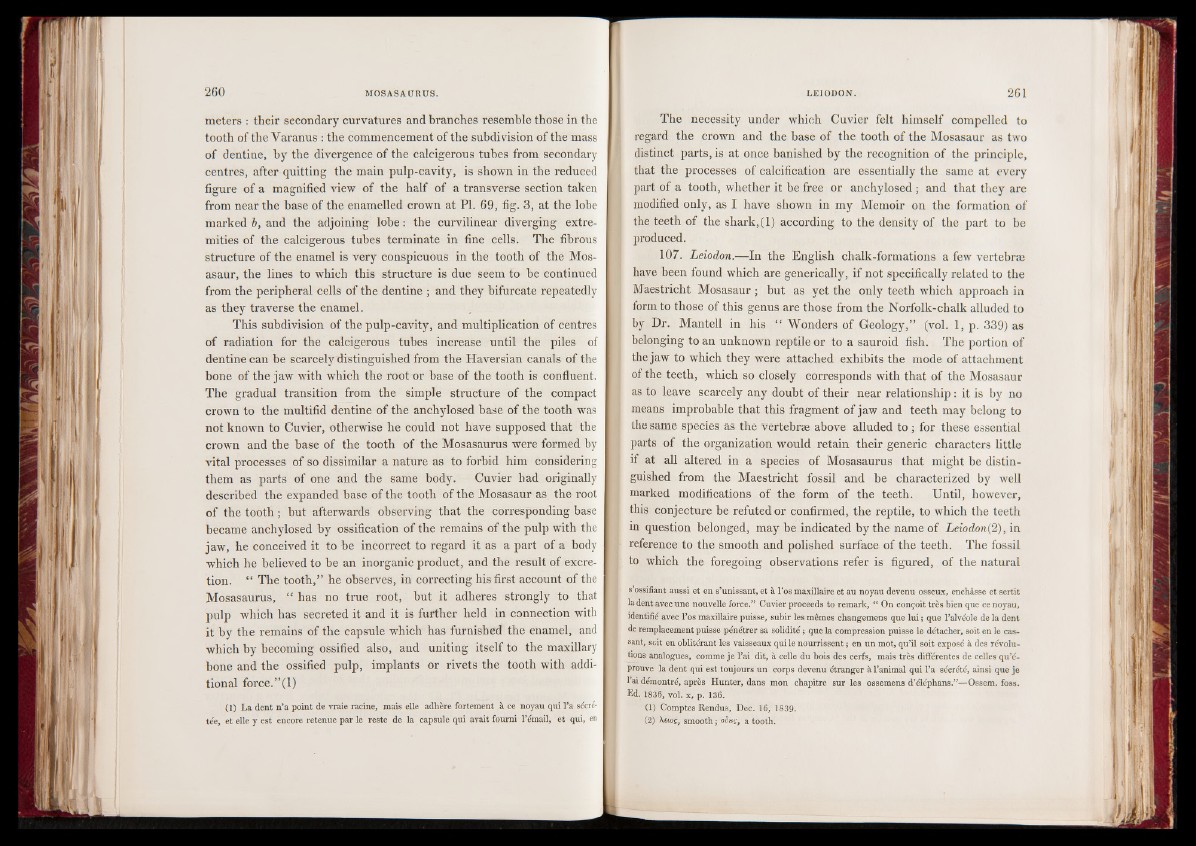
meters : their secondary curvatures and branches resemble those in the
tooth of the Yaranus : the commencement of the subdivision of the mass
of dentine, by the divergence of the calcigerous tubes from secondary
centres, after quitting the main pulp-cavity, is shown in the reduced
figure of a magnified view of the half of a transverse section taken
from near the base of the enamelled crown at PI. 69, fig. 3, at the lobe
marked b, and the adjoining lobe : the curvilinear diverging extremities
of the calcigerous tubes terminate in fine cells. The fibrous
structure of the enamel is very conspicuous in the tooth of the Mos-
asaur, the lines to which this structure is due seem to be continued
from the peripheral cells of the dentine ; and they bifurcate repeatedly
as they traverse the enamel.
This subdivision of the pulp-cavity, and multiplication of centres
of radiation for the calcigerous tubes increase until the piles of
dentine can be scarcely distinguished from the Haversian canals of the
bone of the jaw with which the root or base of the tooth is confluent.
The gradual transition from the simple structure of the compact
crown to the multifid dentine of the anchylosed base of the tooth was
not known to Cuvier, otherwise he could not have supposed that the
crown and the base of the tooth of the Mosasaurus were formed by
vital processes of so dissimilar a nature as to forbid him considering
them as parts of one and the same body. Cuvier had originally
described the expanded base of the tooth of the Mosasaur as the root
of the tooth ; but afterwards observing that the corresponding base
became anchylosed by ossification of the remains of the pulp with the
jaw, he conceived it to be incorrect to regard it as a part of a body
which he believed to be an inorganic product, and the result of excretion.
“ The tooth,” he observes, in correcting his first account of the
Mosasaurus, “ has no true root, but it adheres strongly to that
pulp which has secreted it and it is further held in connection with
it by the remains of the capsule which has furnished the enamel, and
which by becoming ossified also, and uniting itself to the maxillary
bone and the ossified pulp, implants or rivets the tooth with additional
force. ”(1)
(1) La dent n’a point de vraie racine, mais elle adhère fortement à ce noyau qui l’a sécrétée,
et elle y est encore retenue par le reste de la capsule qui avait fourni l’émail, et qui, en
The necessity under which Cuvier felt himself compelled to
regard the crown and the base of the tooth of the Mosasaur as two
distinct parts, is at once banished by the recognition of the principle,
that the processes of calcification are essentially the same at every
part of a tooth, whether it be free or anchylosed ; and that they are
modified only, as I have shown in my Memoir on the formation of
the teeth of the shark, (1) according to the density of the part to be
produced.
107. Leiodon.—In the English chalk-formations a few vertebrae
have been found which are generically, if not specifically related to the
Maestricht Mosasaur ; but as yet the only teeth which approach in
form to those of this genus are those from the Norfolk-chalk alluded to
by Dr. Mantell in his “ Wonders of Geology,” (vol. 1 , p. 339) as
belonging to an unknown reptile or to a sauroid fish. The portion of
the jaw to which they were attached exhibits the mode of attachment
of the teeth, which so closely corresponds with that of the Mosasaur
as to leave scarcely any doubt of their near relationship : it is by no
means improbable that this fragment of jaw and teeth may belong to
the same species as the vertebras above alluded to ; for these essential
parts of the organization would retain their generic characters little
if at all altered in a species of Mosasaurus that might be distinguished
from the Maestricht fossil and be characterized by well
marked modifications of the form of the teeth. Until, however,
this conjecture be refuted or confirmed, the reptile, to which the teeth
in question belonged, may be indicated by the name of Leiodon(2), in
reference to the smooth and polished surface of the teeth. The fossil
to which the foregoing observations refer is figured, of the natural
s’ossifiant aussi et en s’unissant, et à l’os maxillaire et au noyau devenu osseux, enchâsse et sertit
la dent avec une nouvelle force.” Cuvier proceeds to remark, “ On conçoit très bien que ce noyau,
identifié avec l’os maxillaire puisse, subir les mêmes changemens que lui ; que l’alvéole de la dent
de remplacement puisse pénétrer sa solidité ; que la compression puisse le détacher, soit en le cassant,
soit en oblitérant les vaisseaux qui le nourrissent ; en un mot, qu’il soit exposé à des révolutions
analogues, comme je l’ai dit, à celle du bois des cerfs, mais très différentes de celles qu’éprouve
la dent qui est toujours un corps devenu étranger à l’animal qui l’a sécrété, ainsi que je
l’ai démontré, après Hunter, dans mon chapitre sur les ossemens d’éléphans.”—Ossem. foss.
Ed. 1836, vol. x, p. 136.
(1) Comptes Rendus, Dec. 16, 1839.
(2) Xe*oç, smooth j odsçt a tooth.